Analyzing Financial Techniques in Business Decision Making
VerifiedAdded on 2023/06/12
|7
|1279
|467
Report
AI Summary
This report assesses corporate decision-making by examining key financial techniques, specifically the payback period and Net Present Value (NPV). It emphasizes the importance of evaluating various options and selecting the most promising alternative for long-term investments, such as purchasing property, facilities, and equipment. The payback period method, suitable for short-term businesses, estimates the time required to recoup an initial investment but overlooks the time value of money. The NPV method evaluates prospective financial inflows, aiding in determining project viability; a positive NPV indicates a potentially successful venture. The analysis includes a comparison of two projects, A and B, with different initial outlays and predicted yields, highlighting that Project B, with a higher NPV, is the more fiscally viable option. Beyond financial metrics, the report considers non-financial factors like the impact on assets, operating expenditures, return on investment (ROI), and net profitability, as well as employee enthusiasm and customer satisfaction, all of which influence overall business success. The report concludes that effective corporate decision-making requires a comprehensive financial analysis combined with consideration of broader operational and social impacts.

Business Decision
Making
Making
Paraphrase This Document
Need a fresh take? Get an instant paraphrase of this document with our AI Paraphraser
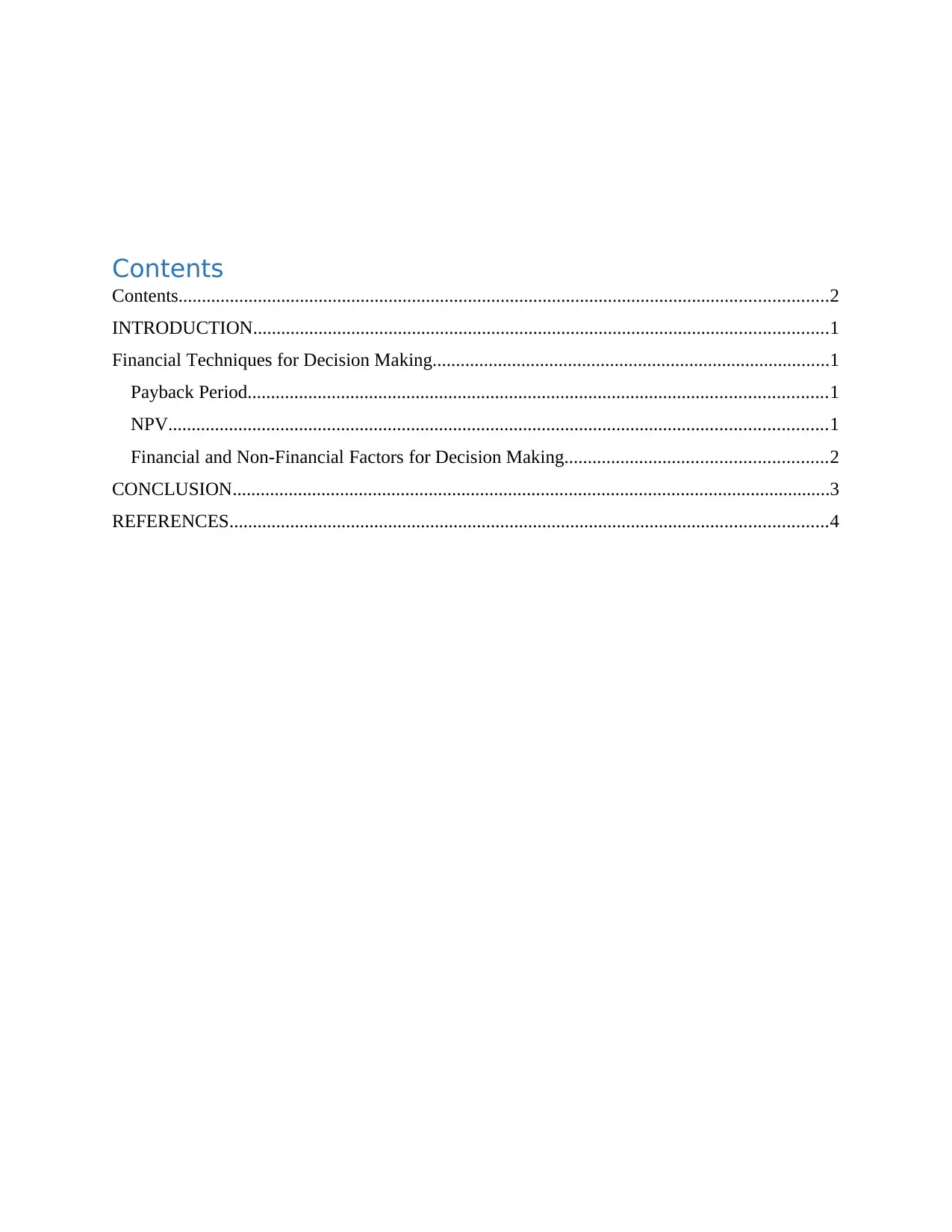
Contents
Contents...........................................................................................................................................2
INTRODUCTION...........................................................................................................................1
Financial Techniques for Decision Making.....................................................................................1
Payback Period............................................................................................................................1
NPV.............................................................................................................................................1
Financial and Non-Financial Factors for Decision Making........................................................2
CONCLUSION................................................................................................................................3
REFERENCES................................................................................................................................4
Contents...........................................................................................................................................2
INTRODUCTION...........................................................................................................................1
Financial Techniques for Decision Making.....................................................................................1
Payback Period............................................................................................................................1
NPV.............................................................................................................................................1
Financial and Non-Financial Factors for Decision Making........................................................2
CONCLUSION................................................................................................................................3
REFERENCES................................................................................................................................4

⊘ This is a preview!⊘
Do you want full access?
Subscribe today to unlock all pages.

Trusted by 1+ million students worldwide
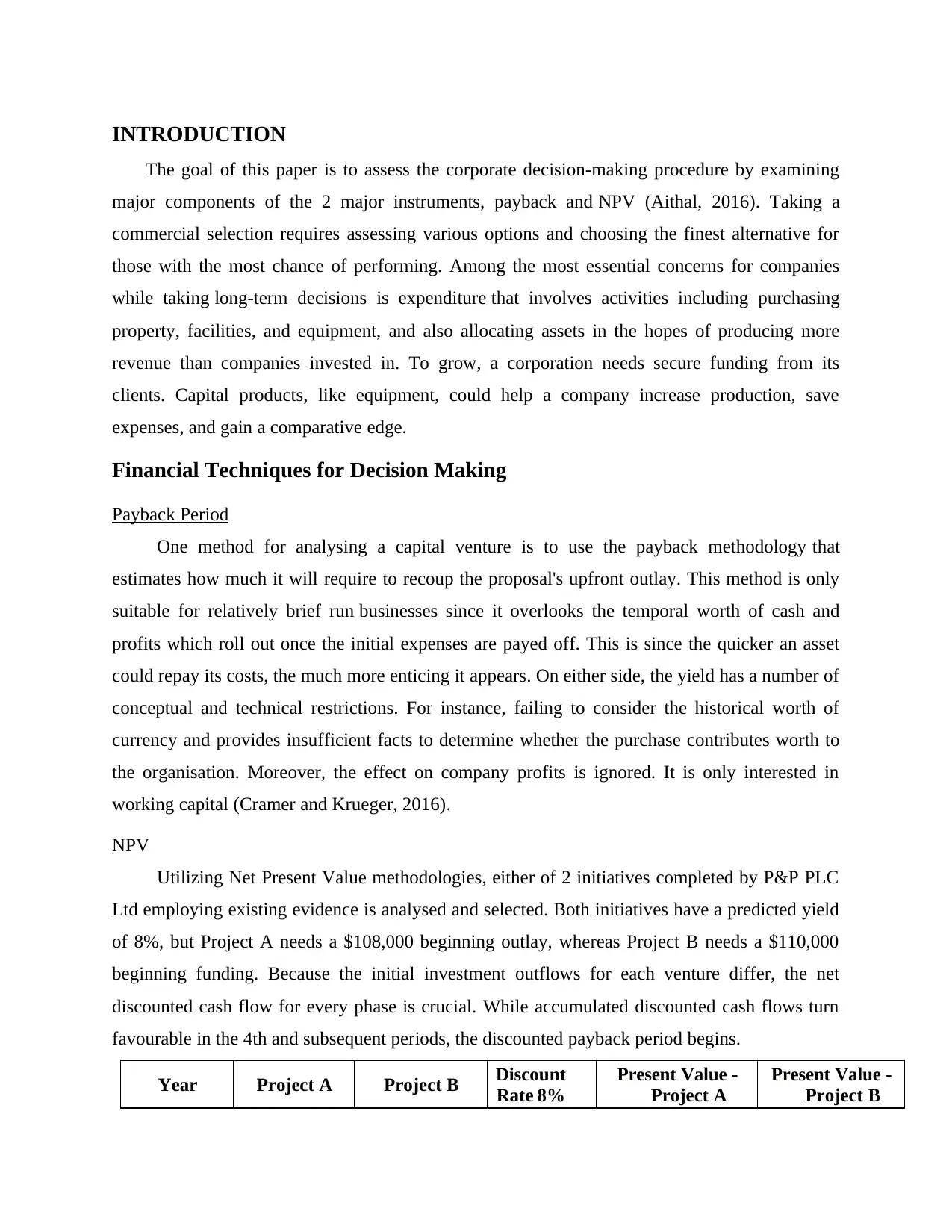
INTRODUCTION
The goal of this paper is to assess the corporate decision-making procedure by examining
major components of the 2 major instruments, payback and NPV (Aithal, 2016). Taking a
commercial selection requires assessing various options and choosing the finest alternative for
those with the most chance of performing. Among the most essential concerns for companies
while taking long-term decisions is expenditure that involves activities including purchasing
property, facilities, and equipment, and also allocating assets in the hopes of producing more
revenue than companies invested in. To grow, a corporation needs secure funding from its
clients. Capital products, like equipment, could help a company increase production, save
expenses, and gain a comparative edge.
Financial Techniques for Decision Making
Payback Period
One method for analysing a capital venture is to use the payback methodology that
estimates how much it will require to recoup the proposal's upfront outlay. This method is only
suitable for relatively brief run businesses since it overlooks the temporal worth of cash and
profits which roll out once the initial expenses are payed off. This is since the quicker an asset
could repay its costs, the much more enticing it appears. On either side, the yield has a number of
conceptual and technical restrictions. For instance, failing to consider the historical worth of
currency and provides insufficient facts to determine whether the purchase contributes worth to
the organisation. Moreover, the effect on company profits is ignored. It is only interested in
working capital (Cramer and Krueger, 2016).
NPV
Utilizing Net Present Value methodologies, either of 2 initiatives completed by P&P PLC
Ltd employing existing evidence is analysed and selected. Both initiatives have a predicted yield
of 8%, but Project A needs a $108,000 beginning outlay, whereas Project B needs a $110,000
beginning funding. Because the initial investment outflows for each venture differ, the net
discounted cash flow for every phase is crucial. While accumulated discounted cash flows turn
favourable in the 4th and subsequent periods, the discounted payback period begins.
Year Project A Project B Discount
Rate 8%
Present Value -
Project A
Present Value -
Project B
The goal of this paper is to assess the corporate decision-making procedure by examining
major components of the 2 major instruments, payback and NPV (Aithal, 2016). Taking a
commercial selection requires assessing various options and choosing the finest alternative for
those with the most chance of performing. Among the most essential concerns for companies
while taking long-term decisions is expenditure that involves activities including purchasing
property, facilities, and equipment, and also allocating assets in the hopes of producing more
revenue than companies invested in. To grow, a corporation needs secure funding from its
clients. Capital products, like equipment, could help a company increase production, save
expenses, and gain a comparative edge.
Financial Techniques for Decision Making
Payback Period
One method for analysing a capital venture is to use the payback methodology that
estimates how much it will require to recoup the proposal's upfront outlay. This method is only
suitable for relatively brief run businesses since it overlooks the temporal worth of cash and
profits which roll out once the initial expenses are payed off. This is since the quicker an asset
could repay its costs, the much more enticing it appears. On either side, the yield has a number of
conceptual and technical restrictions. For instance, failing to consider the historical worth of
currency and provides insufficient facts to determine whether the purchase contributes worth to
the organisation. Moreover, the effect on company profits is ignored. It is only interested in
working capital (Cramer and Krueger, 2016).
NPV
Utilizing Net Present Value methodologies, either of 2 initiatives completed by P&P PLC
Ltd employing existing evidence is analysed and selected. Both initiatives have a predicted yield
of 8%, but Project A needs a $108,000 beginning outlay, whereas Project B needs a $110,000
beginning funding. Because the initial investment outflows for each venture differ, the net
discounted cash flow for every phase is crucial. While accumulated discounted cash flows turn
favourable in the 4th and subsequent periods, the discounted payback period begins.
Year Project A Project B Discount
Rate 8%
Present Value -
Project A
Present Value -
Project B
Paraphrase This Document
Need a fresh take? Get an instant paraphrase of this document with our AI Paraphraser
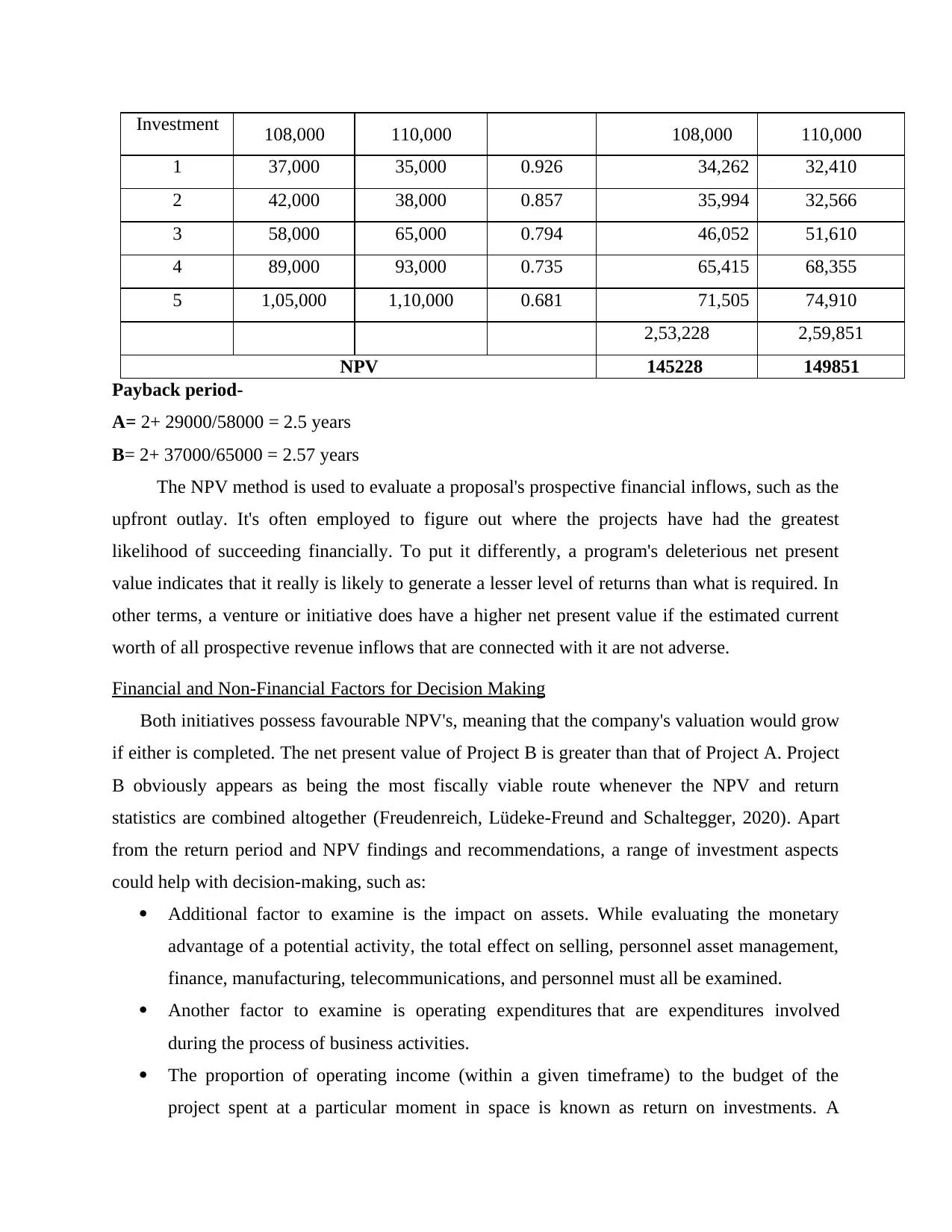
Investment 108,000 110,000 108,000 110,000
1 37,000 35,000 0.926 34,262 32,410
2 42,000 38,000 0.857 35,994 32,566
3 58,000 65,000 0.794 46,052 51,610
4 89,000 93,000 0.735 65,415 68,355
5 1,05,000 1,10,000 0.681 71,505 74,910
2,53,228 2,59,851
NPV 145228 149851
Payback period-
A= 2+ 29000/58000 = 2.5 years
B= 2+ 37000/65000 = 2.57 years
The NPV method is used to evaluate a proposal's prospective financial inflows, such as the
upfront outlay. It's often employed to figure out where the projects have had the greatest
likelihood of succeeding financially. To put it differently, a program's deleterious net present
value indicates that it really is likely to generate a lesser level of returns than what is required. In
other terms, a venture or initiative does have a higher net present value if the estimated current
worth of all prospective revenue inflows that are connected with it are not adverse.
Financial and Non-Financial Factors for Decision Making
Both initiatives possess favourable NPV's, meaning that the company's valuation would grow
if either is completed. The net present value of Project B is greater than that of Project A. Project
B obviously appears as being the most fiscally viable route whenever the NPV and return
statistics are combined altogether (Freudenreich, Lüdeke-Freund and Schaltegger, 2020). Apart
from the return period and NPV findings and recommendations, a range of investment aspects
could help with decision-making, such as:
Additional factor to examine is the impact on assets. While evaluating the monetary
advantage of a potential activity, the total effect on selling, personnel asset management,
finance, manufacturing, telecommunications, and personnel must all be examined.
Another factor to examine is operating expenditures that are expenditures involved
during the process of business activities.
The proportion of operating income (within a given timeframe) to the budget of the
project spent at a particular moment in space is known as return on investments. A
1 37,000 35,000 0.926 34,262 32,410
2 42,000 38,000 0.857 35,994 32,566
3 58,000 65,000 0.794 46,052 51,610
4 89,000 93,000 0.735 65,415 68,355
5 1,05,000 1,10,000 0.681 71,505 74,910
2,53,228 2,59,851
NPV 145228 149851
Payback period-
A= 2+ 29000/58000 = 2.5 years
B= 2+ 37000/65000 = 2.57 years
The NPV method is used to evaluate a proposal's prospective financial inflows, such as the
upfront outlay. It's often employed to figure out where the projects have had the greatest
likelihood of succeeding financially. To put it differently, a program's deleterious net present
value indicates that it really is likely to generate a lesser level of returns than what is required. In
other terms, a venture or initiative does have a higher net present value if the estimated current
worth of all prospective revenue inflows that are connected with it are not adverse.
Financial and Non-Financial Factors for Decision Making
Both initiatives possess favourable NPV's, meaning that the company's valuation would grow
if either is completed. The net present value of Project B is greater than that of Project A. Project
B obviously appears as being the most fiscally viable route whenever the NPV and return
statistics are combined altogether (Freudenreich, Lüdeke-Freund and Schaltegger, 2020). Apart
from the return period and NPV findings and recommendations, a range of investment aspects
could help with decision-making, such as:
Additional factor to examine is the impact on assets. While evaluating the monetary
advantage of a potential activity, the total effect on selling, personnel asset management,
finance, manufacturing, telecommunications, and personnel must all be examined.
Another factor to examine is operating expenditures that are expenditures involved
during the process of business activities.
The proportion of operating income (within a given timeframe) to the budget of the
project spent at a particular moment in space is known as return on investments. A
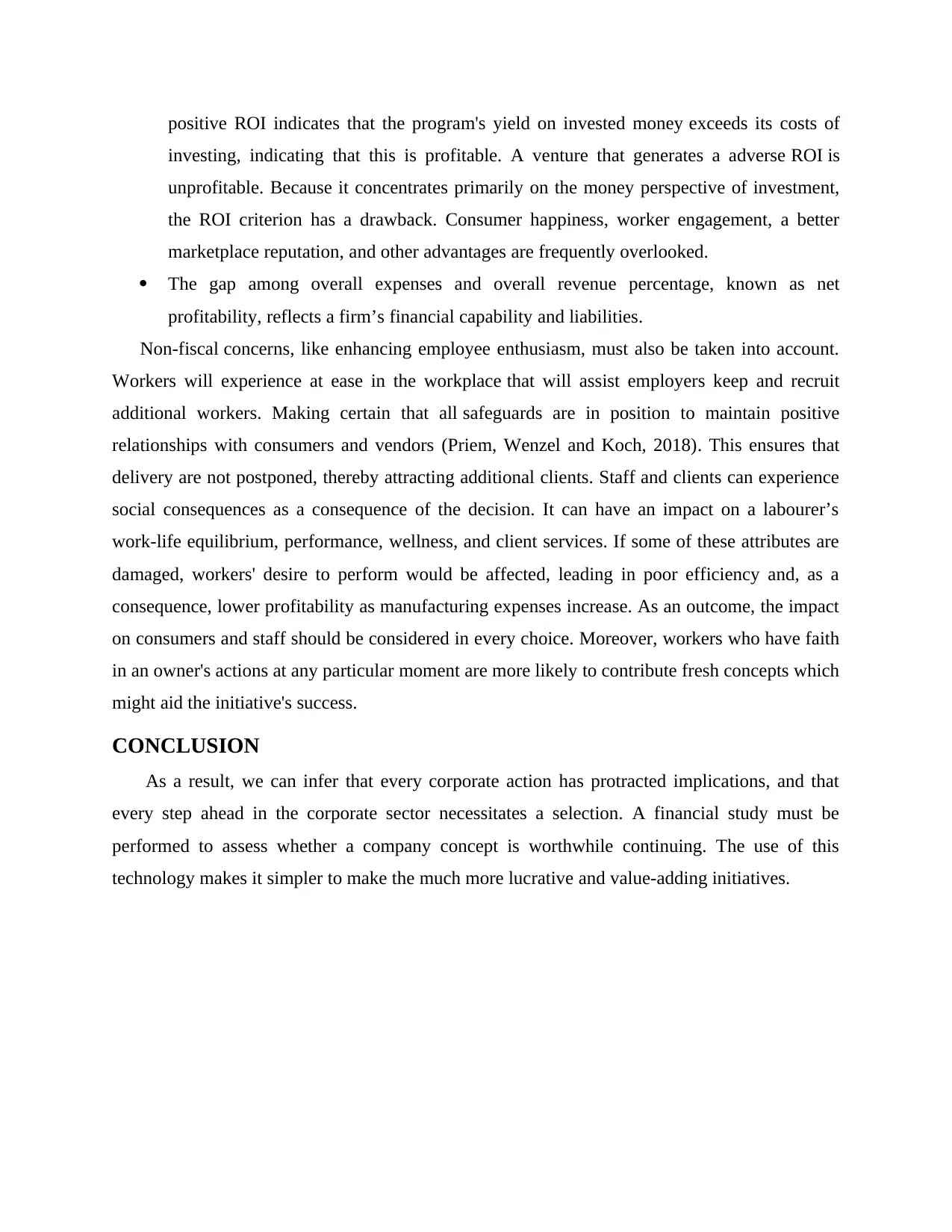
positive ROI indicates that the program's yield on invested money exceeds its costs of
investing, indicating that this is profitable. A venture that generates a adverse ROI is
unprofitable. Because it concentrates primarily on the money perspective of investment,
the ROI criterion has a drawback. Consumer happiness, worker engagement, a better
marketplace reputation, and other advantages are frequently overlooked.
The gap among overall expenses and overall revenue percentage, known as net
profitability, reflects a firm’s financial capability and liabilities.
Non-fiscal concerns, like enhancing employee enthusiasm, must also be taken into account.
Workers will experience at ease in the workplace that will assist employers keep and recruit
additional workers. Making certain that all safeguards are in position to maintain positive
relationships with consumers and vendors (Priem, Wenzel and Koch, 2018). This ensures that
delivery are not postponed, thereby attracting additional clients. Staff and clients can experience
social consequences as a consequence of the decision. It can have an impact on a labourer’s
work-life equilibrium, performance, wellness, and client services. If some of these attributes are
damaged, workers' desire to perform would be affected, leading in poor efficiency and, as a
consequence, lower profitability as manufacturing expenses increase. As an outcome, the impact
on consumers and staff should be considered in every choice. Moreover, workers who have faith
in an owner's actions at any particular moment are more likely to contribute fresh concepts which
might aid the initiative's success.
CONCLUSION
As a result, we can infer that every corporate action has protracted implications, and that
every step ahead in the corporate sector necessitates a selection. A financial study must be
performed to assess whether a company concept is worthwhile continuing. The use of this
technology makes it simpler to make the much more lucrative and value-adding initiatives.
investing, indicating that this is profitable. A venture that generates a adverse ROI is
unprofitable. Because it concentrates primarily on the money perspective of investment,
the ROI criterion has a drawback. Consumer happiness, worker engagement, a better
marketplace reputation, and other advantages are frequently overlooked.
The gap among overall expenses and overall revenue percentage, known as net
profitability, reflects a firm’s financial capability and liabilities.
Non-fiscal concerns, like enhancing employee enthusiasm, must also be taken into account.
Workers will experience at ease in the workplace that will assist employers keep and recruit
additional workers. Making certain that all safeguards are in position to maintain positive
relationships with consumers and vendors (Priem, Wenzel and Koch, 2018). This ensures that
delivery are not postponed, thereby attracting additional clients. Staff and clients can experience
social consequences as a consequence of the decision. It can have an impact on a labourer’s
work-life equilibrium, performance, wellness, and client services. If some of these attributes are
damaged, workers' desire to perform would be affected, leading in poor efficiency and, as a
consequence, lower profitability as manufacturing expenses increase. As an outcome, the impact
on consumers and staff should be considered in every choice. Moreover, workers who have faith
in an owner's actions at any particular moment are more likely to contribute fresh concepts which
might aid the initiative's success.
CONCLUSION
As a result, we can infer that every corporate action has protracted implications, and that
every step ahead in the corporate sector necessitates a selection. A financial study must be
performed to assess whether a company concept is worthwhile continuing. The use of this
technology makes it simpler to make the much more lucrative and value-adding initiatives.
⊘ This is a preview!⊘
Do you want full access?
Subscribe today to unlock all pages.

Trusted by 1+ million students worldwide
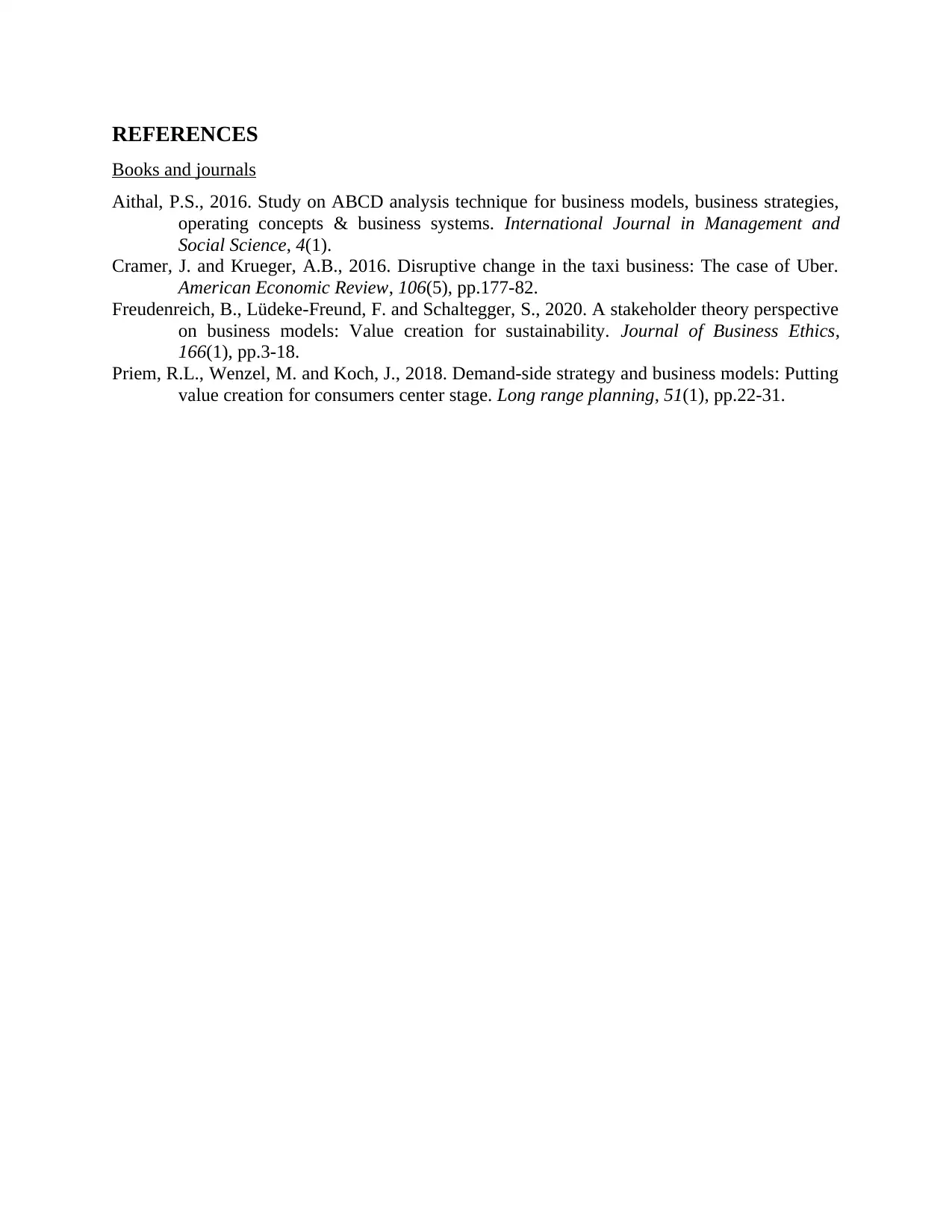
REFERENCES
Books and journals
Aithal, P.S., 2016. Study on ABCD analysis technique for business models, business strategies,
operating concepts & business systems. International Journal in Management and
Social Science, 4(1).
Cramer, J. and Krueger, A.B., 2016. Disruptive change in the taxi business: The case of Uber.
American Economic Review, 106(5), pp.177-82.
Freudenreich, B., Lüdeke-Freund, F. and Schaltegger, S., 2020. A stakeholder theory perspective
on business models: Value creation for sustainability. Journal of Business Ethics,
166(1), pp.3-18.
Priem, R.L., Wenzel, M. and Koch, J., 2018. Demand-side strategy and business models: Putting
value creation for consumers center stage. Long range planning, 51(1), pp.22-31.
Books and journals
Aithal, P.S., 2016. Study on ABCD analysis technique for business models, business strategies,
operating concepts & business systems. International Journal in Management and
Social Science, 4(1).
Cramer, J. and Krueger, A.B., 2016. Disruptive change in the taxi business: The case of Uber.
American Economic Review, 106(5), pp.177-82.
Freudenreich, B., Lüdeke-Freund, F. and Schaltegger, S., 2020. A stakeholder theory perspective
on business models: Value creation for sustainability. Journal of Business Ethics,
166(1), pp.3-18.
Priem, R.L., Wenzel, M. and Koch, J., 2018. Demand-side strategy and business models: Putting
value creation for consumers center stage. Long range planning, 51(1), pp.22-31.
1 out of 7
Related Documents
Your All-in-One AI-Powered Toolkit for Academic Success.
+13062052269
info@desklib.com
Available 24*7 on WhatsApp / Email
![[object Object]](/_next/static/media/star-bottom.7253800d.svg)
Unlock your academic potential
Copyright © 2020–2025 A2Z Services. All Rights Reserved. Developed and managed by ZUCOL.


